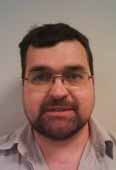Dr. George Palasantzas
The NewScientist article Casimir effect put to work as a nano-switch said
“A new technique that takes control of the Casimir effect ?a strange quantum phenomenon that gums up nanoelectromechanical systems (NEMS) ?may pave the way to a switch that could cut the power consumption of nanoscale gadgets.The Casimir effect tends to force together two parallel conducting plates when they are a few micrometres apart or less. It arises because of the quantum electromagnetic fluctuations that always occur in a vacuum. The close proximity of the two plates constrains the fluctuations in the gap between them. This makes the fluctuation between the plates weaker than those in the surrounding space, so the plates are pushed together.
Group member George Palasantzas at the University of Groningen in the Netherlands says this phenomenon could be used to build a new type of low-power nanoswitch. The switch would be physically moved by altering the state of the AIST, and so changing the strength of the Casimir force.
‘The state remains stable even when power is turned off, which is a unique feature,’ Palasantzas says — unlike existing nanoswitches, such as those used to switch the transmission frequency in mobile phones.”
George Palasantzas, Ph.D. is Assistant Professor, Nanostructured Materials and Interfaces Group Zernike Institute for Advanced Materials and Materials innovation institute M2i University of Groningen, The Netherlands.
George authored Roughness spectrum and surface width of self-affine fractal surfaces via the K-correlation model, Static and dynamic aspects of the rms local slope of growing random surfaces, Self-affine fractals and the limit H→ 0, Roughness effects on the electrostatic-image potential near a dielectric interface, and Surface roughness and grain boundary scattering effects on the electrical conductivity of thin films, and coauthored Polarity-dependent reversible resistance switching in Ge?b?e phase-change thin films. Read the full list of his publications!
He earned his Ph.D. from Northeastern University in 1994 with the dissertation “X-Ray reflectivity and Scanning Tunneling Microscopy Study of Kinetic Roughening of Silver Films”.
